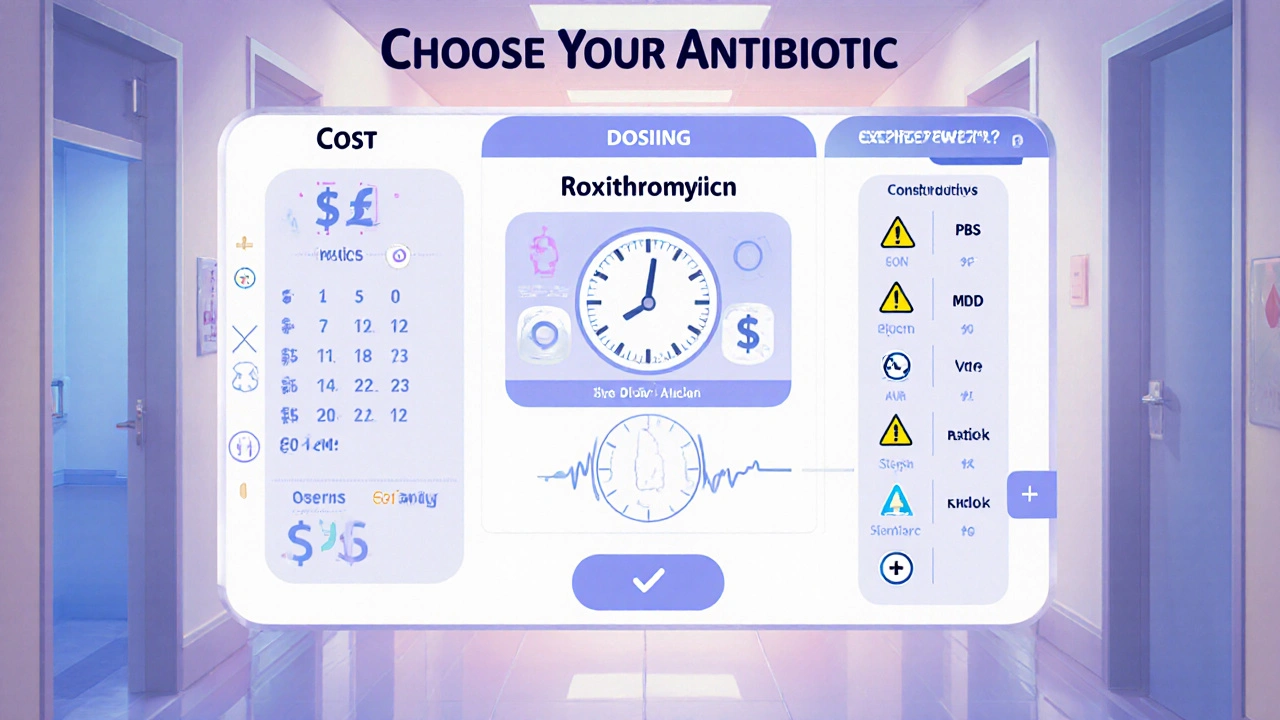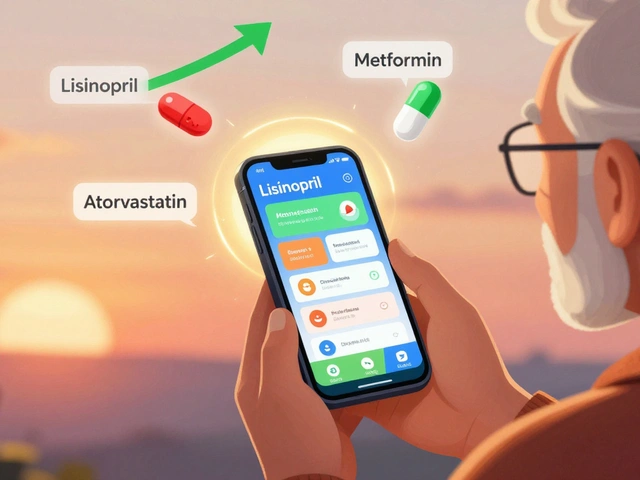Antibiotic Cost Calculator
Compare Antibiotic Costs
Select the antibiotic and treatment duration to calculate your out-of-pocket costs in Australia.
When doctors treat common respiratory infections, Roxithromycin ( marketed as Rulide) is a macrolide antibiotic that works by blocking bacterial protein synthesis. It’s often prescribed for bronchitis, sinusitis, and atypical pneumonia, especially when patients can’t tolerate older macrolides.
Why Compare Roxithromycin with Other Antibiotics?
Choosing the right antibiotic is a balancing act: you need coverage against the likely bugs, a tolerable side‑effect profile, convenient dosing, and reasonable cost. If you or a loved one has been offered Roxithromycin, you might wonder how it stacks up against the more familiar azithromycin or the newer fluoroquinolones. This guide walks through the most common alternatives, highlights the key differences, and helps you ask the right questions at the pharmacy.
Core Attributes to Evaluate
Every antibiotic can be judged on a handful of criteria that matter to both clinicians and patients. Below are the six attributes we’ll compare:
- Spectrum of activity - which bacteria are reliably killed?
- Typical dosing schedule - how many pills and how often?
- Common indications - the infections each drug is most often used for.
- Side‑effect profile - frequency of GI upset, liver enzyme changes, QT prolongation, etc.
- Cost & insurance coverage - out‑of‑pocket price in Australia.
- Availability - whether it’s listed on the PBS (Pharmaceutical Benefits Scheme).
Top Alternatives to Roxithromycin
We focused on antibiotics that doctors frequently consider when they need a macrolide‑type effect or a broader gram‑negative reach. Each alternative is introduced with a short definition wrapped in schema.org markup for easy indexing.
Azithromycin is a long‑acting macrolide that allows once‑daily dosing for 3‑5 days, making it popular for travel‑related diarrhea and Chlamydia.
Clarithromycin is a newer macrolide with a slightly broader respiratory‑pathogen coverage than erythromycin and is often used for H. pylori eradication.
Erythromycin is the classic macrolide, notable for its gastric‑stimulating effect, but it requires multiple daily doses and has more GI side effects.
Levofloxacin belongs to the fluoroquinolone class, offering strong activity against atypical organisms and a convenient once‑daily regimen, yet it carries warnings about tendon rupture.
Doxycycline is a tetracycline derivative that is inexpensive, works well for tick‑borne diseases, and can be taken with food, but it may cause photosensitivity.

Side‑by‑Side Comparison Table
| Attribute | Roxithromycin (Rulide) | Azithromycin | Clarithromycin | Erythromycin | Levofloxacin | Doxycycline |
|---|---|---|---|---|---|---|
| Spectrum | Gram‑positive, atypicals, some gram‑negative | Gram‑positive, atypicals, limited gram‑negative | Broad gram‑positive, atypicals, H. pylori | Gram‑positive, limited atypicals | Broad gram‑positive & gram‑negative, atypicals | Gram‑positive, atypicals, rickettsial |
| Dosing | 150mg twice daily for 7‑10days | 500mg once daily for 3days (or 5‑day regimen) | 500mg twice daily for 7‑14days | 250‑500mg four times daily | 500mg once daily for 5‑7days | 100mg twice daily for 7‑14days |
| Common Indications | Acute bronchitis, sinusitis, atypical pneumonia | Community‑acquired pneumonia, otitis media, STIs | Upper respiratory infections, H. pylori, skin infections | Dermatologic conditions, gastric motility disorders | Complicated urinary tract infections, severe pneumonia | Lyme disease, acne, malaria prophylaxis |
| Side‑effects | Mild GI upset, rare hepatic enzyme rise | Diarrhea, occasional QT prolongation | Metallic taste, liver enzyme elevation | Abdominal cramps, nausea, drug interactions | Tendon inflammation, QT prolongation, CNS effects | Photosensitivity, esophageal irritation |
| Cost (AU$) | ~$30 for 10‑day pack (generic) | ~$20-$25 for 5‑day pack | ~$35 for 14‑day pack | ~$22 for 5‑day pack | ~$45 for 5‑day pack | ~$15 for 14‑day pack |
| PBS Listing | Yes (under generic macrolide) | Yes (generic azithromycin) | No - usually private prescription | Yes (older formulations) | No - restricted unless specialist | Yes - generic doxycycline covered |
When to Prefer Roxithromycin
Roxithromycin shines in a few specific scenarios:
- Patients need a twice‑daily regimen (better adherence than four‑times‑daily erythromycin).
- Cost sensitivity is high but PBS coverage is required - Roxithromycin’s generic form is cheaper than many newer macrolides.
- Clinicians want a macrolide with a slightly longer half‑life, reducing peak‑trough fluctuations.
However, if the infection is likely caused by fluoroquinolone‑susceptible gram‑negative bacteria, levofloxacin might achieve faster bacterial clearance, albeit with higher safety warnings.
Potential Pitfalls and Drug Interactions
All macrolides share a tendency to inhibit the cytochromeP4503A4 enzyme. This means that concurrent use of statins, certain anti‑arrhythmics, or immunosuppressants can raise blood levels of those drugs. Roxithromycin is a moderate inhibitor, so the interaction risk is a bit lower than with erythromycin but not negligible.
Another common issue is GI upset. Taking the tablet with food can blunt stomach irritation, but if a patient experiences persistent diarrhea, switching to azithromycin’s once‑daily dosing may improve tolerance.

Practical Tips for Patients
- Set a reminder on your phone for the 12‑hour dosing interval - missing a dose can lower efficacy.
- Complete the full course even if symptoms improve after 2‑3days; stopping early fuels resistance.
- Stay hydrated and avoid alcohol if you notice liver‑related symptoms (rare, but reported).
- Ask your pharmacist whether a PBS authority prescription is needed for the brand versus generic version.
Bottom Line: Which Antibiotic Fits Your Situation?
There’s no one‑size‑fits‑all answer. If you’re after a low‑cost, twice‑daily macrolide with decent coverage for typical community‑acquired pneumonia, Roxithromycin (Rulide) is a solid pick. For a shorter treatment window or when you need to limit pill burden, azithromycin’s three‑day regimen wins. When dealing with resistant gram‑negative infections, levofloxacin offers broader power but demands careful monitoring. Always let your prescriber weigh the infection type, your medical history, and any potential drug interactions before the final decision.
Frequently Asked Questions
Is Roxithromycin effective against COVID‑19?
No. Roxithromycin is an antibacterial, not an antiviral. It may be used to treat a secondary bacterial lung infection that can follow a viral illness, but it does not clear the virus itself.
Can I take Roxithromycin if I’m pregnant?
Category B in Australia - animal studies show no risk, but human data are limited. Discuss with your doctor; they may prefer a different antibiotic if safety is a concern.
How does the cost of Roxithromycin compare to generic azithromycin?
Roxithromycin generally costs a bit more per tablet, but because it’s taken twice daily for ten days, the total out‑of‑pocket expense can be similar or slightly higher than a 5‑day azithromycin pack. PBS subsidies often equalise the price difference.
What should I do if I miss a dose?
Take the missed dose as soon as you remember, unless it’s less than 6hours before the next scheduled dose. In that case, skip the missed one and continue with the regular schedule - don’t double‑dose.
Are there any food restrictions with Roxithromycin?
It can be taken with or without food. If you experience stomach upset, a light snack helps. Avoid grapefruit juice, which can increase macrolide levels.







Taylor Van Wie
October 16, 2025 AT 17:39Roxithromycin's twice‑daily schedule beats the four‑times‑daily grind.
chuck thomas
October 19, 2025 AT 11:39When you compare macrolides, look beyond the headline dosage.
The pharmacokinetic half‑life determines steady‑state concentrations more than the number of pills per day.
Roxithromycin's moderate 12‑hour interval can smooth plasma peaks, potentially reducing GI irritation.
However, clinicians must also weigh CYP3A4 inhibition, especially when patients are on statins.
The cost‑benefit balance in a PBS‑covered system often tips the scales toward the generic option.
Rohit Poroli
October 22, 2025 AT 05:39The therapeutic index of Roxithromycin aligns closely with that of clarithromycin, yet its spectrum excludes some resistant gram‑negative strains.
In terms of bioavailability, the drug achieves approximately 80 % systemic exposure when administered with food, which can mitigate gastric discomfort.
Clinicians should monitor hepatic transaminases in patients with pre‑existing liver dysfunction, as modest elevations have been documented.
Drug‑drug interaction vigilance is warranted for agents metabolized via CYP3A4, particularly macrolide‑sensitive anticoagulants.
Ultimately, patient‑specific factors dictate the optimal macrolide choice.
William Goodwin
October 24, 2025 AT 23:39Roxithromycin offers a neat middle ground between efficacy and convenience 😊.
Its twice‑daily dosing is less burdensome than erythromycin's quadri‑daily regimen, and the side‑effect profile sits between azithromycin and clarithromycin.
For travelers prone to gastrointestinal upset, taking the tablets with a light snack can make a noticeable difference.
Ken Elelegwu
October 27, 2025 AT 16:39The emphasis on half‑life overlooks the real‑world adherence challenges that many patients face.
Even a smooth plasma curve falters if a dose is missed due to the twelve‑hour schedule.
Moreover, the modest CYP3A4 inhibition, while less than erythromycin, still poses a risk for statin accumulation.
In practice, the simplicity of a three‑day azithromycin course often translates to higher completion rates.
Gene Nilsson
October 30, 2025 AT 10:39Antibiotic stewardship demands that physicians prescribe the narrowest effective agent.
Deploying broad‑spectrum macrolides without clear indication undermines public health.
Roxithromycin should be reserved for documented cases where alternative agents are contraindicated.
Vintage Ireland
November 2, 2025 AT 04:39Got the generic pack of Roxithromycin and it was surprisingly easy on the stomach.
Worth a try if you’re looking for a cost‑effective macrolide.
Anshul Gupta
November 4, 2025 AT 22:39The missed‑dose scenario you described is precisely why many guidelines now favor once‑daily regimens.
Patient adherence data consistently support the shorter courses.
Maryanne robinson
November 7, 2025 AT 16:39Roxithromycin occupies a unique niche among macrolides, offering a balance of pharmacodynamic potency and patient-friendly dosing.
Its spectrum covers common respiratory pathogens such as Streptococcus pneumoniae, Haemophilus influenzae, and atypical organisms like Mycoplasma pneumoniae.
When selecting an antibiotic, clinicians must first assess the local resistance patterns, as regional macrolide resistance can diminish effectiveness.
In Australia, the PBS subsidy for generic Roxithromycin makes it economically attractive compared to brand‑name azithromycin, especially for extended ten‑day courses.
The drug’s moderate inhibition of CYP3A4 means drug‑drug interactions are less severe than with erythromycin, yet caution remains advisable for patients on calcium channel blockers or certain antiretrovirals.
Patients often report mild gastrointestinal upset, which can typically be mitigated by taking the medication with food or a small snack.
Unlike azithromycin's high tissue penetration, Roxithromycin maintains steady serum concentrations, reducing the risk of sub‑therapeutic peaks that could foster resistance.
Adherence is facilitated by the twice‑daily schedule, which fits well into common waking and bedtime routines.
However, the twelve‑hour interval requires disciplined reminder systems; mobile alerts have been shown to improve compliance.
For individuals with a history of QT prolongation, baseline ECG monitoring is recommended before initiating any macrolide, including Roxithromycin.
Cost analysis shows that while the per‑tablet price may be slightly higher, the total expense over a ten‑day regimen aligns closely with a five‑day azithromycin pack once PBS rebates are applied.
Clinicians should also consider contraindications such as severe hepatic impairment, where dose adjustments or alternative agents may be necessary.
In cases of mixed infections involving gram‑negative bacilli, a fluoroquinolone like levofloxacin may provide superior coverage, albeit with its own safety considerations.
Patient education on completing the full course, even after symptom resolution, remains a cornerstone of preventing antimicrobial resistance.
Overall, Roxithromycin is a solid choice for uncomplicated community‑acquired respiratory infections when cost, coverage, and dosing convenience align with patient needs.
Dileep Jha
November 10, 2025 AT 10:39While the overview highlights many strengths, it glosses over the limited activity against resistant gram‑negative strains that are increasingly prevalent.
Moreover, the reliance on PBS subsidies can mask the true cost when patients require extended therapy.
Some clinicians argue that the newer macrolide‑resistant organisms render Roxithromycin a suboptimal first‑line option.
A shift toward pathogen‑directed therapy would mitigate these concerns.
Michael Dennis
November 13, 2025 AT 04:39The article presents a comprehensive table, yet it fails to address the evolving resistance trends in Southeast Asia.
Such omissions limit its applicability to global practice.
Blair Robertshaw
November 15, 2025 AT 22:39Truth is, the data on resistance is all over the place and the piece just skimps on it.
If you want real insight, look at the WHO reports.
Claus Rossler
November 18, 2025 AT 16:39Presuming Roxithromycin is the default macrolide ignores the fact that azithromycin's single‑dose regimen has higher patient satisfaction scores.
In many cases, clinicians overlook newer tetracycline options that offer comparable efficacy with fewer cardiac risks.
A more nuanced algorithm would benefit prescribers.